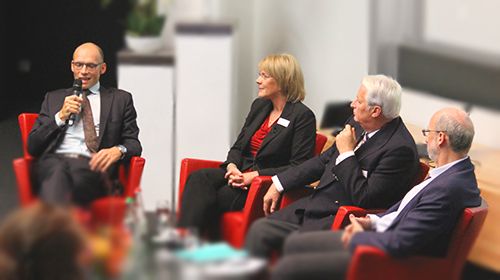
by Stuart Pallister, Associate Director, Lausanne Hospitality Research Center
With Marriott`s $13.6 billion acquisition of Starwood Hotels now complete, Marriott chief executive Arne Sorenson will be contemplating how to capture as much value as possible from the deal. As with all such M&A activity though the apparent benefits will only be realized with a well-implemented plan when it comes to bringing together what may be very different corporate cultures.
At a recent panel discussion on “How is the hotel industry going to attract and retain the talent of the future?” staged at Ecole hôteliere de Lausanne (EHL), panelists with decades of industry experience shared their views on the mega-merger.
Nick van Marken, Global Head of Hospitality at Deloitte, who has interviewed Sorenson on the deal, said the most obvious benefit is scale. The Group will now have 30 brands, 5,700 hotels, over one million rooms and will be present in 110 countries. Underpinning that is loyalty. “This is about combining the power of Marriott Rewards with SPG (the Starwood Preferred Guest loyalty programme). Get this right and you have 75 million loyal customers which Marriott can then try to ensure book direct, reducing the impact of OTAs (online travel agents).”
For Marriott, it is also an opportunity to move into spaces it hasn’t previously been in.
According to Susan Devine, Senior Vice President of Strategic Development with Preferred Hotels & Resorts, ‘soft’ brands like Preferred, which provides sales and marketing support for independent hotels, have been emerging in the hospitality industry. Now with the consolidation of ‘hard’ brands like Marriott and Starwood, large corporations will be exploring how they can offer their services to the hospitality industry generally.
“The reason they are doing this is because independent hotels don’t necessarily need the same things as before. You have the internet now, so does it really matter if you have the Marriott name? You can research a hotel before you go there, so there’s an opportunity for hotels to stay independent.”
“On the other hand, hotels need more support because revenue and distribution, the way in which business is driven in hospitality, is much more complex. You have OTAs, you can’t just think about brochures and travel agents. You’re looking at a whole different model of distribution which is very fast moving. So hotels need sales and marketing support. They need to be connected with global partners.”
“The hard brands – the Marriotts and Starwoods – are beginning to offer some of these services in different ways. But they’ll have to start moving more quickly otherwise these spaces will be taken – and we’re already seeing that. So the vision of hospitality is broadening,” Devine said.
“When we all started our careers and you walked through the doors of a hotel and it said Holiday Inn on the roof that meant it was likely to be managed by Holiday Inn, owned by Holiday Inn, and operated under Holiday Inn brand infrastructure,” van Marken said. “Now you can walk into a hotel as a consumer and you’ll be completely unaware that the building – the real estate portion — is owned by one party, the management delivered by another party, and the brand can be a franchise. Add that the actual method of booking may be via someone completely different (i.e. an OTA) and you have four interested parties.”
In Singapore, he added, a hotel has opened which only takes reservations via booking.com. “That is effectively their channel of choice. They have no sales and marketing team. Priceline’s market cap is equivalent to the combined market cap of InterContinental, Marriott and Hilton, so you can see which way the financial markets are betting.”
L-R: Jonathan Humphries, Susan Devine, Jean-Marc Grosfort, Nick van Marken
Another panelist, Jean-Marc Grosfort, the Managing Director of Worldwide Hotel Development, had previously worked for both Marriott and Starwood. The two corporations had different approaches and structures, he said, and processes will now have to be learnt and unlearnt.
“The new generation is shaping the future and I saw it when Arne Sorenson became president. He protected the deep values created and implemented by Mr Marriott but took the corporation to a second speed of doing business with the firm intention of accelerating development, moving from a traditional and centralized structure to a more global and assertive approach. What will be challenging will be to take the best of the old values and reshape them to make the future work.”
Marriott had built its business on taking care of its people, who in turn would take care of the guests, who would keep coming back. “That’s Mr Marriott’s mantra. He learnt it from his parents and is still talking about it,” van Marken said, adding that the corporation is still, in effect, a family business. “He’s probably the last guy at the top of a major hotel company which actually has his name on it, and that makes a huge difference.”
Bill Marriott had hand-picked Sorenson as his successor as, according to van Marken, he had a clear vision and ev6eryone at Marriott believed in him.
“You need to get people to follow you,” van Marken added. “If you don’t, you’re going to have a very short career.”
Jonathan Humphries writes:

For the ongoing integration, the trick will be to retain key talent within the organization and continue to attract new talent. There is significant knowledge and experience within both organizations, and although there is an expectation that the transition to the future for the combined entity should be swift, it is important that both the new and old employees try and understand each other’s perspectives and show “mutual respect”. This attribute was prioritized by EHL students as the top decision criterion for selecting future employers.
The new energy, enthusiasm and drive created, plus the strong culture, history and previous successes have the potential to create a very powerful combination and give Marriott-Starwood a strong competitive edge. There is ultimately going to be a fallout during this process, however. Existing employees should remind themselves of the quote from the well-known futurist Alvin Toffler, who said that “the mantra for the 21st century should be the ability to learn, unlearn and relearn”.
This article is published courtesy of EHL Hospitality Insights.
- Jonathan Humphries is a Senior Lecturer at EHL with nearly 20 years` experience in the hotel and real estate sectors.
- Stuart Pallister is Associate Director of the Lausanne Hospitality Research Center.


